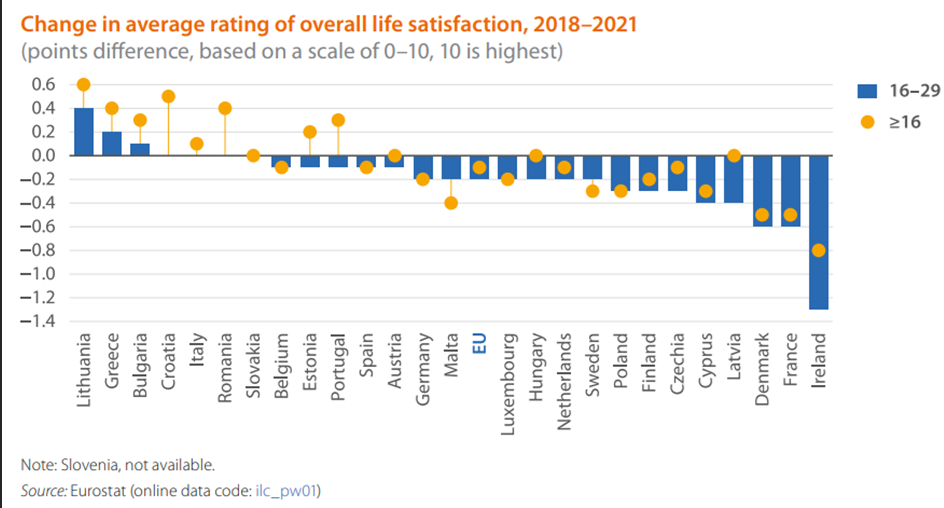In this blog post, we will talk about “Motivating Hopeless Young People”. Young people in the most dynamic years of their lives report feeling stuck, overwhelmed, and depressed. So why do today’s young people experience these feelings more intensely? Anxiety about the future, economic problems, and loneliness. That is to say, there are many reasons why young people feel hopeless. What does scientific research say about this? You will find answers to all these questions. In writing this blog post, we aim to explore the concept of hopeless adolescents and highlight the difficulties they face. We will also discuss how we can help young people reach their full potential. Join us as we explore ways of motivating hopeless youth. You can reach our other youth-related topics in the youth category. We are cooperating with Mevhibe Ateş Teknoloji Vakfı for finding solution ideas.
Let’s look at the statistics published by Eurostat, the statistical office of the European Union.

Motivating Hopeless Youth: Financial Worries and Job Instability
Our teenage years coincide with the years we build our careers and lay the foundations. This transition period from childhood to adulthood is already psychologically tricky, and taking essential steps about our future makes it even more difficult.
Here are some of the problems of hopeless youth: Uncertainty between being financially dependent on the family and being independent, indecision in choosing a profession and consequently low job satisfaction, pressure from some families on the child to choose a profession, etc.
In the graph below, you will see the unemployment rates of young people in recent years.

Differences between 2019 and 2021 show a decline in labour markets worldwide. Also, the COVID-19 pandemic is considered to have a significant impact on this decline. In the EU, the youth employment rate fell by 2.3 percentage points between 2019 and 2020 but increased by 1.6 percentage points in 2021, offsetting some of these losses, so the youth employment rate 2021 was 0.7 percentage points below its pre-pandemic level (in 2019). In 2021, young employment rates increased in five EU Member States compared to 2019: France, Ireland, Denmark, Netherlands, and Germany. The EU countries with the lowest employment rates are Bulgaria, Latvia, Portugal, and Slovenia.
Lack of Goal and Motivation
Youth is a period of self-knowledge, so it is not easy for young people to set goals. Certainly, determining what they would be happy in and finding fulfilling paths that align with their values and passions causes them tremendous stress and anxiety.
Locke (2002) says goal-directed action is how we meet our wants and find happiness. This is done through value application, quest, and achievement.
Locke, E. A. (2002). Setting goals for life and happiness. In C. R. Snyder & S. J. Lopez (Eds.), Handbook of positive psychology (pp. 299–312). New York: Oxford University Press.
Also, Diener (1984) has known for a long time that pursuing goals consciously makes people feel better and happier (see Deci and Ryan, 2000, for more on this).
Diener, E. (1984). Subjective well-being. Psychological Bulletin, 95, 542–575.
For example, Emmons (1986) and Emmons and Diener (1986) looked at college students and found that perceived goal importance, goal attainment, and goal realization are all linked to life satisfaction and positive attitude.
Emmons, R. A., & Diener, E. (1986). A goal-affect analysis of everyday situational choices. Journal of Research in Personality, 20, 309–326.
Motivating Hopeless Youth: The Lack of Proper Guidance and Mentorship
Another important cause of hopelessness among young people is the lack of mentors. They struggle to find mentors who can provide the support, advice, and encouragement they need. Moreover, the lack of appropriate role models can hinder young people’s personal and professional development, leaving them feeling lost and hopeless. On the other hand, not knowing which direction to take, young people may feel isolated and out of the flow of life. This can quickly reduce their motivation to continue and lead to self-esteem problems.
As they set their goals and living standards, young people need role models to help them find themselves. This can be a family member or an external person, such as a school psychologist.
Social Media Effect
Another factor that reduces young people’s life satisfaction and drives them to despair is social media. Social media includes people of all statuses; reaching them is just a click away. To clarify, it is inevitable for young people to compare their own lives with the lives they see.
In addition, social media is a platform that does not generally reflect reality. Everyone seems very happy there, and no one posts when they are sad. For example, this leads young people to think, “I am the only one with a problem, and all my friends and other people go on with their lives”.
Future Anxiety and Academic Stress
Uncertainty about the future is another stressor for young people. Undecided young people may despair about the future when choosing a profession.
Creed et al. (2003) looked at groups of adult workers and found that losing a job or being unemployed harms mental health and can lower self-esteem. In the same way, a longitudinal study with teens has shown that young people who drop out of school and don’t get a job report lower levels of self-reported activity, perceived skill, and life stability, as well as more depressive feelings (see Feather and O’Brien, 1986).
Creed, P. A., Muller, J., & Patton, W. (2003). Leaving high school: The influence and consequences for psychological well-being and career-related confidence. Journal of Adolescence, 26, 295–311.
Feather, N. T., & O’Brien, G. E. (1986). A longitudinal study of the effects of employment and unemployment on school-leavers. Journal of Occupational Psychology, 59, 121–144.
Moreover, there is an exam system every high school passes for higher education. You can see that this exam is an end-of-chapter monster from the perspective of young people. Also, it causes relentless comparison and competition with their peers, becomes a matter of life and death among young people. The pursuit of academic excellence leads to a feeling of constant striving without satisfaction.
Motivating Hopeless Youth: Solutions
We can work in many different areas to reduce youth hopelessness. There are two types of activities; internal and external activities. Intrinsic activities refer to work that young people can do independently, while extrinsic activities refer to activities that people and institutions around young people can do.
Motivating Hopeless Youth: Creating Supportive Ecosystems
Strong social connections and support systems are vital for overall life satisfaction. Creating ecosystems that support their development is crucial to overcome the challenges “hopeless youth” faces. The development of these ecosystems should start in families. Firstly, families can be educated about the hopelessness of young people and how they can support them. After families, schools are the most critical communities in young people’s lives. Secondly, teachers should have more knowledge and experience in guiding and motivating young people. Offering relevant mentoring programs and promoting mental health awareness can solve hopelessness. Furthermore, providing platforms for young people’s voices to be heard and respected can foster a sense of belonging and purpose.
What can young people do about their hopelessness?
Youths can learn strategies from school psychologists and mental health workers to overcome hopelessness. In addition, we have compiled some essential strategies for all young people who know what they want but feel hopeless and lack the energy to take action.
Let’s see what we can do!
Wolters 2003, mentioned some strategies for the regulation of motivation, and these are;
Motivating Hopeless Youth: Attribution Control
People use this technique when they choose causal attributions to keep or boost their motivation for a task or a similar task in the future.
They may try to avoid saying that their failure in school was caused by internal, set, and unchangeable causes because this can make them feel helpless (Weiner, 1986).
Weiner, B. (1986). An attributional theory of motivation and emotion. NewYork: Springer-Verlag.
They can achieve a more adaptive motivational outcome when they use attributions that reflect internal and controllable conditions.
Goal-Oriented Self-Talk
When individuals lose motivation to do something, they may try to convince themselves to continue. They can deliberately think and write down positive outcomes as a way of motivation. This way, they remind themselves why they should do it.
Motivating Hopeless Youth: Self-Consequating
This strategy involves young people identifying and applying extrinsic reinforcers or punishments to achieve specific goals associated with completing a task. For instance, of this strategy might be offering oneself a favourite dessert if one achieves a goal. In some research, this process is called “self-empowerment”. However, they can also rely on punishments and reinforcers to influence their motivation and behaviour. For example, if a person fails to achieve a set goal, s/he may forbid himself to play on the computer, one of his or her favourite activities.
Emotion Regulation
Emotion control is a method for regulating students’ motivation levels in educational environments.
It refers to a student’s capacity to control the emotional experiences they have so that they can put in the effort necessary to accomplish academic assignments. (Corno, 1993; Schutz & Davis, 2000).
Corno, L. (1993). The best-laid plans: Modern conceptions of volition and educational research. Educational Researcher, 22, 14–22.
In this context, emotion control is often necessary to reduce adverse emotional reactions and harmful effects associated with performance evaluations (Spielberger & Vagg, 1995; Zeidner, 1998).
Spielberger, C., & Vagg, P. (Eds.). (1995). Test anxiety: Theory, assessment, and treatment. Washington, DC: Taylor & Francis.
To clarify, students can employ a variety of specialized coping mechanisms to manage their emotional responses, including wishful thinking, counting slowly to 10, and breathing deliberately, slowly and deeply.
Conclusion
To sum up, the idea is that hopeless young people are becoming more real. Low life satisfaction among young people has many causes, including social, economic, and personal issues. To help young people with their problems, it’s essential to understand why they have them in the first place. If we understand and empower their issues therefore we can change the story about young people from hopeless to limitless potential. We can reduce hopelessness by prioritizing mental health and providing guidance on discovering personal meaning and purpose. Also, encouraging them to develop a healthy relationship with social media and financial literacy are some of the solutions. Above all, this will lead to a generation that is happier, more satisfied, and better able to deal with life’s difficulties.
Also, follow our social media to keep in touch with us.
References
Corno, L. (1993). The best-laid plans: Modern conceptions of volition and educational research. Educational Researcher, 22, 14–22.
Creed, P. A., Muller, J., & Patton, W. (2003). Leaving high school: The influence and consequences for psychological well-being and career-related confidence. Journal of Adolescence, 26, 295–311.
Emmons, R. A., & Diener, E. (1986). A goal-affect analysis of everyday situational choices. Journal of Research in Personality, 20, 309–326.
Diener, E. (1984). Subjective well-being. Psychological Bulletin, 95, 542–575.
Feather, N. T., & O’Brien, G. E. (1986). A longitudinal study of the effects of employment and unemployment on school-leavers. Journal of Occupational Psychology, 59, 121–144.
Locke, E. A. (2002). Setting goals for life and happiness. In C. R. Snyder & S. J. Lopez (Eds.), Handbook of positive psychology (pp. 299–312). New York: Oxford University Press.
Spielberger, C., & Vagg, P. (Eds.). (1995). Test anxiety: Theory, assessment, and treatment. Washington, DC: Taylor & Francis.
Young people in Europe — a statistical summary — 2022 edition. (n.d.). Eurostat. https://ec.europa.eu/eurostat/product?code=ks-06-22-076
Weiner, B. (1986). An attributional theory of motivation and emotion. NewYork: Springer-Verlag.
Wolters, C. A. (2003). Regulation of Motivation: Evaluating an Underemphasized Aspect of Self-Regulated Learning. Educational Psychologist, 38(4), 189–205. https://doi.org/10.1207/s15326985ep3804_1















